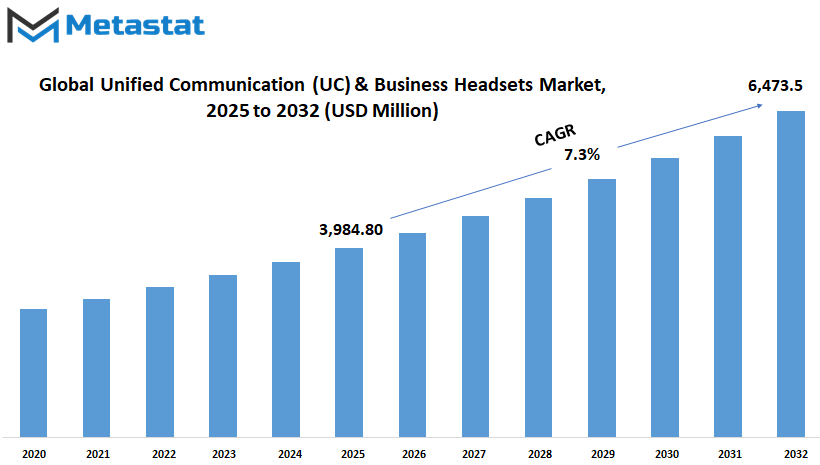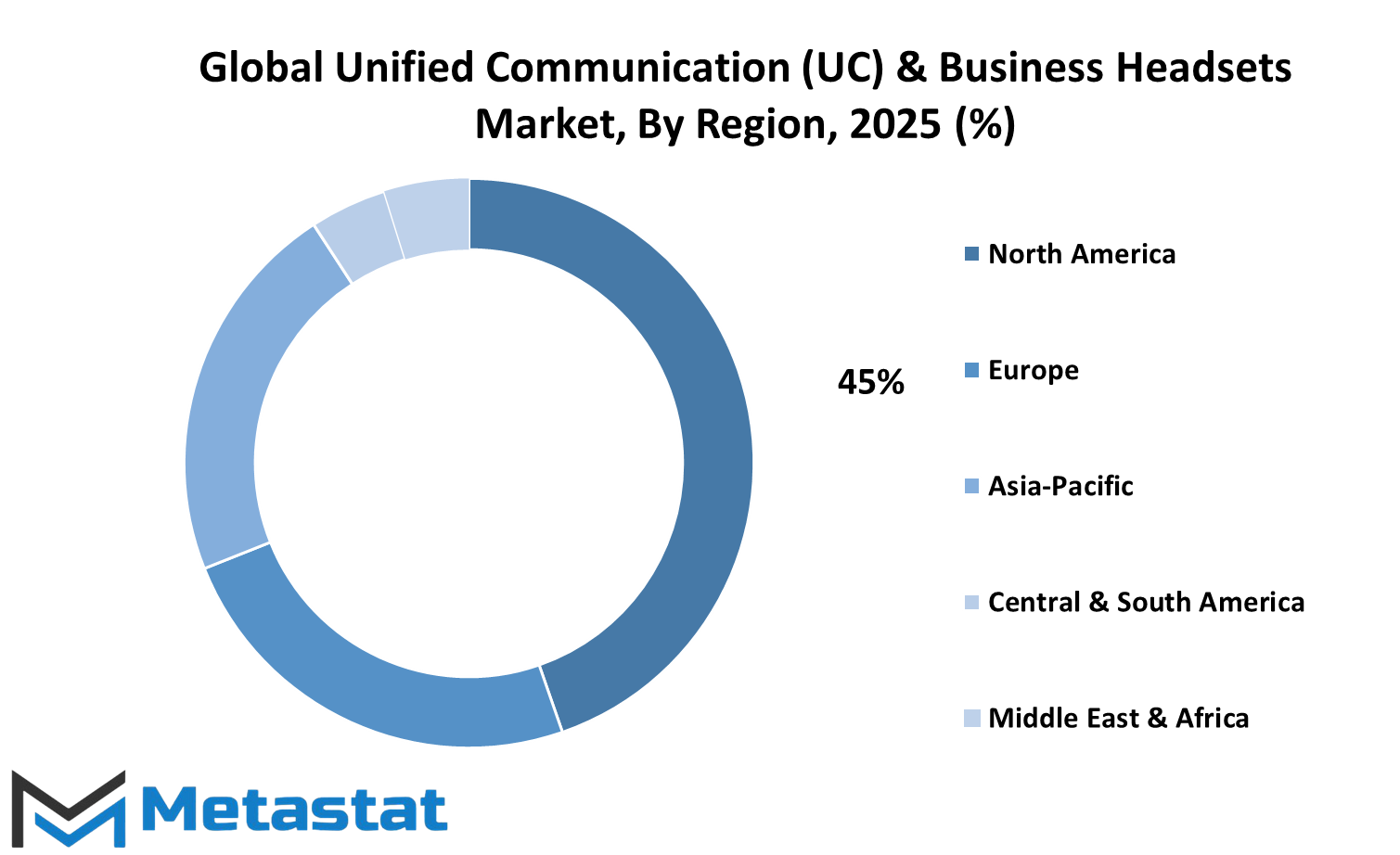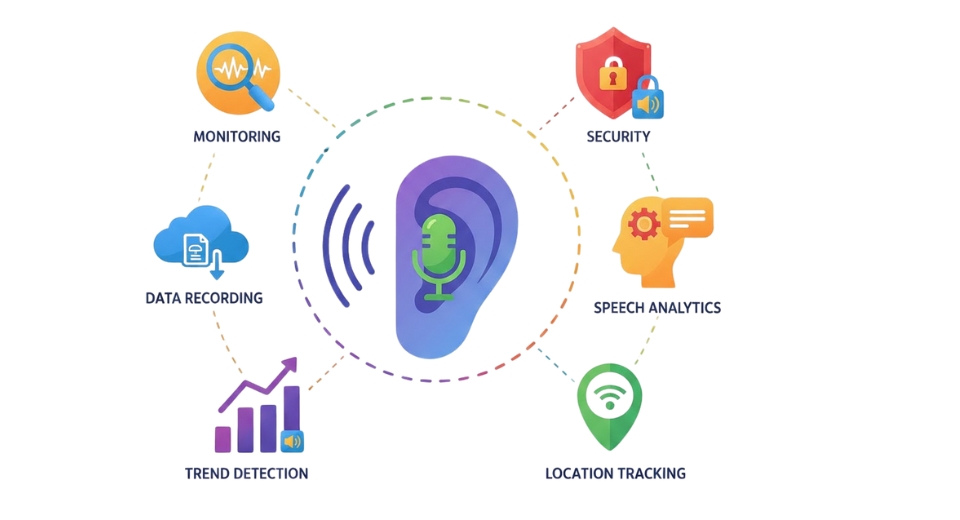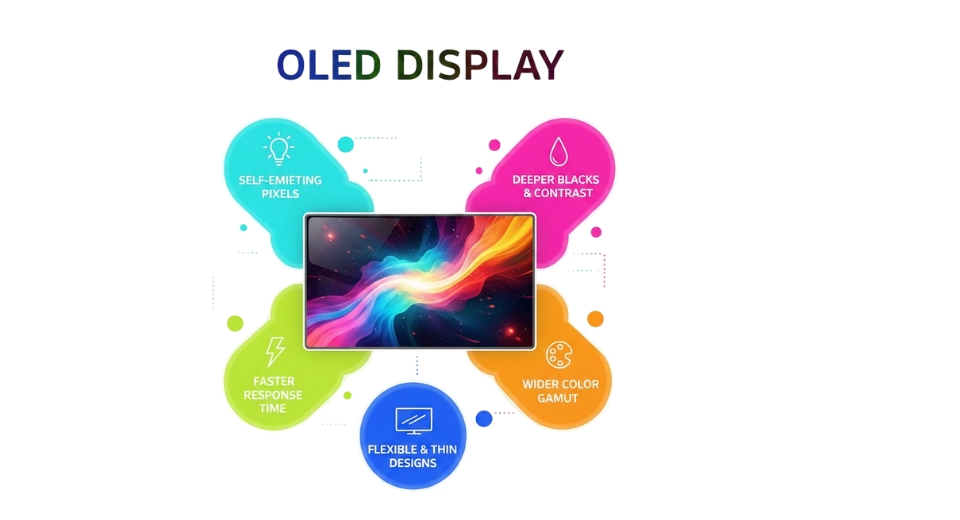MARKET OVERVIEW
The Global Unified Communication (UC) & Business Headsets market is a niche industry within the professional audio equipment and enterprise communication market, serving a specific need for seamless, high-fidelity voice and multimedia transmission in digital work environments. The market relies on the combination of audio devices into communications platforms uniquely configured for business use, including voice-over-IP solutions, video conferencing solutions, customer support interfaces, and cloud-based collaborative networks. As businesses go ahead to redesign traditional work arrangements to virtual or combined patterns, requirements for sound-quality audio solutions will escalate, making this industry an indispensable function within professional spaces throughout the world. The focus within the Global Unified Communication (UC) & Business Headsets industry is developing communication audio equipment designed to speak the language of unified communication systems that integrate disparate mechanisms of communication together under a common umbrella.
UC headsets are not confined to straightforward playback of audio and microphone input only; they also have capability with noise cancellation, digital signal processing, multi-connectivity, and integration into collaboration software. They will have to enable flawless interaction in international teams, virtual conferencing, customer interactions, and therefore are going to become a key component in a very broad range of business processes. The Global Unified Communication (UC) & Business Headsets market will cater to enterprise customers who are in the process of building digital-first communications infrastructure. Business professionals across industries such as finance, IT services, health care, consulting, education, and government will require audio solutions that enhance voice clarity and end-user comfort while maintaining security standards imposed by compliance environments.
Regardless of whether they are operating in crowded call centers, home workstations, or open office environments, customers will need headsets that minimize background noise and smoothly integrate with unified communication platforms like Microsoft Teams, Zoom, Cisco Webex, and Google Meet. Global Unified Communication (UC) & Business Headsets developers will pay more attention to creating headsets with premium ergonomics, wireless connectivity, and long battery life. Voice commands, background noise filtered through AI, and biometric sensors will be commonplace, facilitating smarter interaction and greater productivity. Beyond the hardware, the market will bleed into software-based upgrades like firmware over-the-air updates, IT administrator device management consoles, and data encryption architectures.
These will position headsets further in the broader security and functionality goals of the modern digital workplace. Global Unified Communication (UC) & Business Headsets market will also be influenced by procurement models used by companies, as demand shifts towards headsets that offer quantifiable ROI in terms of ruggedness, usability, and inter-operability across multiple operating systems and communication systems. Large-scale installations will require centralized support, remote diagnostics, and cross-platform compatibility, driving the use of headsets from a peripheral device status to becoming the central part of the communication systems. In the short term, the Global Unified Communication (UC) & Business Headsets market will drive the manner in which business enterprises embrace real-time collaboration and virtual communication. With professional-grade audio as a non-negotiable standard, this market will be a flagship driver in increasing operational productivity and user satisfaction in global and distributed teams.
Global Unified Communication (UC) & Business Headsets market is estimated to reach $6,473.54 Million by 2032; growing at a CAGR of 7.3% from 2025 to 2032.

GROWTH FACTORS
The Global Unified Communication (UC) & Business Headsets market is likely to grow steadily as the nature of work keeps changing towards more flexible and connected workplaces. The increasing demand for remote work and virtual collaboration tools has compelled organizations to look for improved communication systems. With teams usually divided between cities or even nations, the demand for headsets with clear and continuous audio has grown more crucial than ever. Experts want to have the feeling of being in the same room with their team members, even if they are thousands of miles apart, and that is only possible if the equipment they use accommodates smooth and clear communication. Concurrently, professional environments are increasingly demanding noise-canceling and quality sound headsets.
The workplace is not necessarily quiet, and remote employees frequently work out loud in homes or public spaces. The quality headset that can filter out background noise and deliver crisp clean sound serves to enhance concentration and make conversations more productive. This increasing demand is forcing manufacturers to enhance their products, making them more appropriate for work environments where communication is important. Not all things are, however, progressing without bumps. One of the issues at hand is that these headsets do not usually function as well as on every communication platform.
Some of them are specific to certain software, and whenever users attempt to switch between applications, problems develop. This causes frustration and restricts smooth collaboration. Another hindrance is cost, particularly for small companies that wish to offer good tools to their teams but cannot afford to spend money on high-end headsets for all. For such companies, finding a balance between price and quality is not always possible. In the future, the Global Unified Communication (UC) & Business Headsets market may be assisted by artificial intelligence and wireless technologies' new features. These could include smarter and more flexible devices that can switch settings depending on the environment or user behavior. Think of a headset that tweaks volume levels autonomously or a headset that interconnects without effort across systems without setup complexities.
These features would not only enhance the user experience but also make these headsets more attractive to a wider audience of customers. With the proper innovations, the market could open new doors and bring about lasting changes in the way people communicate at work.
MARKET SEGMENTATION
By Product
The Global Unified Communication (UC) & Business Headsets market will see steady alterations in the coming years, with the manner in which people interact and collaborate still changing. As more companies turn to flexible working models, in which employees are able to work from various places, the demand for reliable communication tools is on the rise. Within this arena, headsets particularly earphones and headphones—are becoming popular not just for their ease but also for their function in providing clear communication and smooth collaboration. Headphones are likely to continue to rise in popularity, especially among businesspeople who spend extended periods in meetings or calls.
Their comfort and quality of sound make them perfect for such requirements. These headsets are engineered to minimize background noise, enabling the users to listen and speak clearly without being disrupted. Earphones, however, will most probably be more popular among mobile workers. Due to their compact nature and lighter construction, they can be taken easily and used from various points of work, either at home, a café, or when away from the home office. In the future, technology will dictate how these products continue to advance. Voice clarity, comfort, and battery life will remain significant, but new features are also being included. Headsets that are seamless to use with voice assistants or can hop from one device to another instantly will become the norm. As software is getting smarter, headsets may start having capabilities that respond by changing sound levels according to the surroundings, so it becomes easier to talk even in busy locations. Another driving factor of the Global Unified Communication (UC) & Business Headsets market is virtual meeting growth.
Video conferencing and online collaborations are no longer a short-term trend it is becoming an everyday work lifestyle. Complementing this, businesses are investing in improved tools enabling workers to connect clearly and without technical issues. This shift is likely to prevail as companies seek greater productivity with less travel expenses and less physical office requirements. As this market expands, both headsets and earbuds will have distinct roles. Companies will not only seek sound quality but also solutions that fit their work culture and employee behavior. With continuous enhancements in sound technology, wireless capabilities, and styling, these headsets will remain viable and indispensable devices in coming work environments.
The Global Unified Communication (UC) & Business Headsets market, driven by evolving requirements and more intelligent products, will continue to evolve to enable people to stay connected.
By Type
The Global Unified Communication (UC) & Business Headsets market is headed towards a future defined by the way human beings connect and collaborate. As offices evolve and more businesses practice flexible work schemes, the importance of having convenient and dependable communications equipment is rising further. Professional businesspeople expect their devices now to perform far better than place calls. They desire clarity, mobility, and consistent performance whether they are at home, in the office, or somewhere in between. Unified communication headsets assist in bringing teams together, enhancing concentration during meetings, and minimizing distractions inherent in day-to-day work environments. If we consider the nature of headsets in this space, it is evident that technology will have a significant influence on user preference.
Wired headsets still provide a reliable option for those who value consistency and do not wish to have to worry about battery life. They remain the choice in environments where a consistent connection is paramount. Conversely, Bluetooth headsets are making good strides as more individuals seek devices that enable movement and flexibility. These headsets enable a hands-free experience and are increasingly ubiquitous, particularly with multitasking work. NFC, while less high-profile, has a quick, simple method to pair devices in a tap that may become increasingly popular as instant pairing becomes necessary. Wi-Fi-based headsets are another potentially thrilling option as they provide further freedom of motion and greater cloud-based system integration. And then there are the 'Others', a category that promises innovation yet to be invented. These might be things that have voice recognition, noise canceling that adjusts to various environments, or even intelligent sensors that learn to accommodate the user's routines. In the future, attention will turn even further to unobtrusive user experiences, where communication aids become customized to the user himself, not the reverse. Businesses will keep on investing in products that enhance productivity and decrease weariness.
With technology becoming intelligent, customers will anticipate headsets that act naturally to their requirements, be it through voice commands, auto-configuration, or seamless device shifting. The Global Unified Communication (UC) & Business Headsets market will grow more customized, intelligent, and responsive to how people work. The future of this industry isn't about improved sound it's about making it easy to communicate.
By Price
The Global Unified Communication (UC) & Business Headsets market is slowly becoming increasingly significant as companies continue to evolve the way they communicate. As technology continues to expand, organizations are looking for smoother methods of remaining connected, be it through video conferencing, voice conversations, or virtual meetings. Business headsets are now recognized as critical instruments for sustaining clear, distraction-free communication. In this evolving world, pricing is an important factor where individuals and businesses select the appropriate products. When referring to price, the market is viewed in three general categories.
There are products that come at a cost of up to 50 USD and are generally more simple in appearance but nonetheless effective in sending regular calls and performing everyday tasks. These are usually favored by small groups or solo users who do not require high-end functionality but would like something that is reliable. A step up, the next category features headsets costing between 50 to 100 USD. These models are a favorite because they provide a compromise between price and quality. Features such as improved noise suppression, comfort for extended use, and enhanced microphone clarity are typically anticipated in this category. Last but not least, there is a category that exceeds 100 USD. This category is targeted towards businesses and professionals who prioritize highest-level performance, reliability, and long use. Such headsets typically feature evolved sound technologies and materials that enable them to function in high-traffic environments. In the future, the Global Unified Communication (UC) & Business Headsets market is going to continue growing throughout all price segments. Remote work and hybrid office environments are not disappearing anytime soon, and that will continue to fuel demand.
What could also become more prevalent are smart functions such as voice command, gesture recognition, and smoother integration with multiple devices. These advancements will keep even the lower- and mid-range headsets more capable and functional than they have ever been. One thing that is certain is that prices will remain an important consideration in the equation, but quality and functionality expectations will increase as well. With companies becoming increasingly reliant on digital tools for communications, headsets will be viewed as necessary hardware, not add-ons. In the future, even budget models may have features that were previously reserved for higher-end products. This trend indicates that the market isn't just expanding but is also getting smarter, more practical, and more long-term value-oriented.
By End Use
The global Unified Communication (UC) & Business Headsets market is likely to head toward a future that will be defined by both shifting work patterns and increasing developments in communications equipment. With companies seeking less complicated and more streamlined methods to remain connected within various teams and locations, high-quality headsets designed for UC are likely to see increased demand steadily. Such headsets are no longer about better sound alone. They now feature intelligent capabilities such as noise cancellation, voice control, and support across multiple digital platforms, and therefore are critical devices for contemporary workspaces. The market, as viewed through its various categories of users, reflects how broad the demand for the devices has gotten.
In banking and finance, for instance, security and plain communication are key. High-end headsets facilitate secure and continuous conversations with clients and among teams. In the corporate world, where conferences occur throughout time zones, having reliable audio equipment matters greatly. Businesses are looking for products that operate instantly and continuously without interruption, and that is exactly where UC-validated devices come in. They can bridge on video calls, chat, e-mail, and voice within one seamless installation that is driving much of the corporate world to take the plunge and buy them. Education is yet another field where these headsets are gaining acceptance. With online classes and blended learning on the rise, good sound and simplicity enable the teacher and students to work more productively.
In online retail and e-commerce, fast and clear communication between customers and teams prevents delay and miscommunication. Whether troubleshooting an issue or providing product support, the appropriate headset facilitates smoother interaction. Other industries, from government to healthcare, also value communications tools that enable more effective and accurate communication. Moving forward, the global Unified Communication (UC) & Business Headsets market is poised to be focused on comfort, longer battery duration, and smarter features such as AI-powered noise suppression. Voice analysis and real-time language translation can also become mainstream, further making these headsets effective across languages and geography. As more businesses go hybrid, equipment that facilitates seamless and natural communication will continue to be essential.
|
Forecast Period |
2025-2032 |
|
Market Size in 2025 |
$3,984.80 million |
|
Market Size by 2032 |
$6,473.54 Million |
|
Growth Rate from 2025 to 2032 |
7.3% |
|
Base Year |
2025 |
|
Regions Covered |
North America, Europe, Asia-Pacific, South America, Middle East & Africa |
REGIONAL ANALYSIS
The Global Unified Communication (UC) & Business Headsets market is growing steadily around various regions of the world as it is being influenced by transformation in the manner businesses function, communicate, and connect. With growing reliance of businesses on digital devices to continue to be productive and have communication in an efficient manner, specifically designed business and unified communication headsets have begun gaining popularity across the globe. Every region has its own specific needs and impacts, which combined are determining the overall trend of the market. In North America, there is high demand for business-oriented communication solutions.
This is mainly due to the large number of remote and hybrid work arrangements being implemented. The U.S., in particular, is leading the charge in implementing cloud-based communication systems. As increasingly more Canadian and Mexican companies trend in the same direction, demand for high-quality headsets with good sound and intelligent functionality will continue to increase. Companies in this market seek products that can keep up with an active work pace while being comfortable enough for prolonged use. Europe is also making significant contributions to the future of this marketplace. With nations such as the UK, Germany, France, and Italy being keen on enhancing workplace productivity, business-fitted headsets are starting to be standard office equipment.
With more companies opting for flexible working, particularly in metropolises, utilization of good-quality audio equipment is now a necessity rather than an extravagance. Buyers in this region tend to prioritize strong design, privacy, and effortless integration with all software systems. Asia-Pacific is becoming a strong growth region. India and China are experiencing high growth in business activity and digitalization. With increasing startup culture and growth in the tech industry, the demand for communication tools is on the rise.
Cost-effective headsets that are still offering quality and durability are particularly in demand here. Japan and South Korea, where innovation is stressed, are leading demand for advanced features like noise cancellation and voice control. South America and Middle East & Africa are gradually gaining traction. Brazil and Argentina are experiencing increased remote work and virtual meetings, opening up opportunities for market development. In the Middle East and Africa, areas such as the Gulf and South Africa are embracing new business practices. As connectivity enhances, so will the need for solutions that keep professionals connected. With time, this will contribute to wider acceptance and greater presence of the Global Unified Communication (UC) & Business Headsets market in these regions.

COMPETITIVE PLAYERS
The Global Unified Communication (UC) & Business Headsets market is growing fast due to the surging demand for improved communication tools and smoother collaboration across various industries. Due to more companies embracing remote work solutions, the demand for enhanced business headsets has increased, and thus it is a highly competitive industry. The industry has a number of major players who are contributing in their own way to address the changing demands of businesses globally. Among them, organizations such as Bose Corporation, Cisco Systems Inc., Dell Technologies Inc., and GN Store Nord A/S are taking the lead, providing the latest technology-enabled products capable of enhancing productivity and the clarity of communication. Bose Corporation, with its reputation for audio products of the highest quality, has established itself as a high-end player in the UC headset segment.
Their products are especially popular for the noise-canceling feature that ensures communication remains crystal clear even under loud conditions. Also, Cisco Systems Inc., a global networking leader, has established its presence in the UC market with headsets that are compatible with its communication and collaboration platforms. This compatibility is important for enterprises seeking unified systems that improve the efficiency of communications. Dell Technologies Inc. is another industry giant, offering headsets that are specifically designed to integrate flawlessly with their computing solutions, thereby becoming a favorite among companies that outsource their technology needs to Dell. GN Store Nord A/S, the parent entity of Jabra, is also extremely powerful in the marketplace, famous for manufacturing long-lasting and high-featured headsets for personal as well as large institutional customers. HP Development Company L.P. has established its place in the market with headsets that prioritize comfort and productivity, which are what professionals with hours of calls or virtual meetings need. Koss Corporation and Logitech International S.A. also pose fierce competition, providing high-quality and affordable options that will attract small businesses and large ones alike.
Sennheiser electronic GmbH & Co. KG, yet another renowned name, has established itself strongly in the business headset sector with its performance-oriented audio offerings. Jabra, owned by GN Store Nord A/S, is unique due to its design-oriented approaches and dedication to offering quality audio solutions for business. Yealink, EPOS, and Xiamen Inbertec Electronic Technology Co., Ltd are also progressing well in the market.
These players aim to deliver businesses with low-cost yet quality headsets that provide great communication solutions for large-scale organizations as well as small organizations. With these industry leaders spearheading innovation and competition, the prospects of the Global Unified Communication (UC) & Business Headsets market appear bright with new technologies and features being introduced continuously to satisfy the increasing demand for improved business communication.
Unified Communication (UC) & Business Headsets Market Key Segments:
By Product
- Earphones
- Headphones
By Type
- Wired
- Bluetooth
- NFC
- Wi-Fi
- Others
By Price
- Up to 50 USD
- 50 to 100 USD
- Above 100 USD
By End Use
- BFSI
- Corporate
- Education
- Retail and E-Commerce
- Others
Key Global Unified Communication (UC) & Business Headsets Industry Players
- Bose Corporation
- Cisco Systems Inc.
- Dell Technologies Inc.
- GN Store Nord A/S
- HP Development Company L.P.
- Koss Corporation
- Logitech International S.A.
- Sennheiser electronic GmbH & Co. KG
- JabraYealink
- EPOS
- Xiamen Inbertec Electronic Technology Co., Ltd.
WHAT REPORT PROVIDES
- Full in-depth analysis of the parent Industry
- Important changes in market and its dynamics
- Segmentation details of the market
- Former, on-going, and projected market analysis in terms of volume and value
- Assessment of niche industry developments
- Market share analysis
- Key strategies of major players
- Emerging segments and regional growth potential








 US: +1 3023308252
US: +1 3023308252






